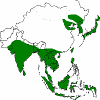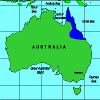Scrub Typhus
Disease: Scrub Typhus
Pathogen: Rickettsia, Rickettsia tsutsugamushi
Vectors: Mites in the family Trombiculidae, genus Leptotrombidium
Reservoir: Humans
Distribution: Southeastern Asia, north Queensland, Australia, and islands of Indian and southwest Pacific Oceans
Other Names: chigger-borne rickettsiosis, tsutsugamushi disease, mite-borne typhus, Japanese river fever, tropical or rural typhus
Scrub typhus, which was first described from Japan, is caused by Rickettsia tsutsugamushi. The causative organism is transmitted to humans through the bite of tiny trombiculid mites. The rickettsia organisms are found throughout the mites body, but the highest number occur in the salivary glands. When the mite feeds on rodents or humans, the disease organisms are transmitted to the host.
Only larval Leptotrombidium mites feed on vertebrate hosts. The larval mites acquire R. tsutsugamushi through their female parent. This type of pathogen reception is called "transovarial transmission."
Once transmitted to the host, R. tsutsugamushi incubates for about 10 to 12 days. After that, victims may experience headaches, fever, anorexia, and general apathy. The site of infection is marked by a lesion--the chigger bite. The infection enlarges to 8 to 12 mm, and the center becomes dark and necrotic. Scarring may occur.
From 5 to 8 days after infection, a dull red rash may appear all over the body, especially on the trunk. Additional symptoms include: enlargement of the spleen, nervous disturbances, delirium, and prostration.
Mortality ranges from 6 to 35 percent. Death either occurs as a direct result of the disease, or from secondary effects, such as bacterial pneumonia, encephalitis, or circulatory failure. If death occurs, it is usually by the end of the second week of infection.
According to Traub and Wisseman (1974), epidemics of scrub typhus are dependent on four factors: (1) Leptotrombidium mites; (2) wild rates in the genus Rattus; (3) the pathogen, R. tsutsugamushi; and (4) distrubed environments with transitional vegetation.
Leptotrombidium akamushi is the primary vector in Japan. The species is found in partially cultivated areas that become inundated with spring and early summer floods. The adults are 1 to 2 mm long, red, and may live for at least 15 months. Adult mites feed on eggs of small insects. Females lay about 400 eggs over a 3- to 5-month period on the soil in damp locations, such as under leaves. Larval mites, only 0.22 mm long, hatch in 10 to 12 days and then wait for a host to feed on. After feeding for 1 to 10 days, the engorged larval mite, which may be 0.55 mm long, drops from the host to the ground and undergoes complex metamorphic changes. These include: an inactive nymphochrysalis stage, a predacious nymphal stage, an inactive imagochrysalis stage, and finally, the adult stage.
Leptotrombidium deliense is the main vector from western Pakistan through southeast Asia to Australia and New Guinea. Its life cycle is similar to L. akamushi. Both species prefer areas of high humidity.
Information Sources
- Harwood, R. F. and M. T. James. 1979. Entomology in human and animal health. Macmillan, New York.
- Traub, R. and C. L. Wisseman. 1974. The ecology of chigger-borne rickettsiosis (scrub typhus). Journal of Medical Entomology 11:237-303.




